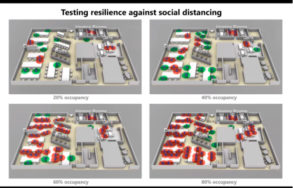
As we look at the recent flow of investment in smart buildings in recent weeks, we look back at last May when we launched our monthly Buildings Analyst Call Series with a panel focused on Covid-19’s impact on the Smart Buildings segment and what emerging building technologies might gain more adoption in the short and long term. For the discussion, we invited:
For the discussion, we invited:
Scott Sass, Special Services Group Leader at DPR
Oliver Baumann, President at Baumann Consulting
Shrikant Sharma, Director of Analytics at Buro Happold
We asked each panelist about what they were working on and seeing in relation to Covid and smart buildings. The whole recording and the recordings of our other analysts calls are available to under our research tab. However, here is a quick look at what they had to say:
Focus on Technology that Helps Optimize Air Flow – Oliver Baumann, President at Baumann Consulting
Oliver Buamann of Baumann Counsulting pointed us to technology that helps manage and optimize air flow, ventilation rates, and flushing more outdoor air into buildings. Beyond optimization the import of outdoor air in buildings, Baumann’s group has been increasingly asked to look at models to ensure that air pressurization is optimized in confined areas such as bathrooms and also open areas such as open floor plan areas to ensure that air is flushed out of buildings. All of this analysis means more work around the HVAC systems in our buildings.
For the long term, he predicted increasing importance in being able to monitor the performance of buildings, air flow and otherwise and also, he saw more focus on resiliency, being able to shut down and restart buildings, and a focus on existing, older buildings and the indoor air quality in those older buildings. He also pointed out the opportunity in advances in cleaning and maintaining buildings.
Focus on Efforts to Create Social Distancing, Versus Facilitating “Social Collisions” – Shrikant Sharma, Director of Analytics, Buro Happold
Shrikant Sharma, from Buro Happold, spoke about their efforts to provide people more and better analytics to help people have confidence about the environments they are putting people into. In particular, he spoke about how they have moved from technology to help people optimize “social collision” in the work place with the goal of fostering greater communication and collaboration. Now, they are leveraging technology to help people understand how socially distanced people are likely to be as they re-enter space. He walked us through technologies that help them understand what social distancing in a space looks like as levels of occupancy vary.
Longer term, he saw a focus on the changing levels of connectivity in the workplace and how that may change the layouts and functions of workspaces. Places like meeting rooms, classrooms, airport terminals, museums, theaters and other buildings will receive new scrutiny, as we think about the future we want to create. Dedicated outdoor air systems are also areas where he sees opportunities, not only to opportunities to create higher quality environments, but also more energy efficient environments. He also alluded to digital occupancy management systems the empower building users by giving them more control over their environments.
Focus on Some of the Non-Traditional Ways Construction Companies Like DPR Are Providing Service to Customers – Scott Sass, Special Services Group Leader, DPR
Scott Sass of DPR talked about how much more attention there is to building commissioning and the benefits of having in-house commisioning capabilities. He described his experience of leading a “tiger team” or focus group of forty people across the company to lead DPR’s restart plan. He is now working with customers, consulting around developing restart plans as a unique service. Longer term, they see demand for Well Building Technology and also a significant expansion of low voltage related work in everything from video conferencing, wifi networks, space monitoring, security, air quality, log in kiosks, auto operators on doors, hands free functions on kitchen appliances and restroom fixtures, and more. He also pointed to an increase in ability to access and even maintain building maintenance equipment, remotely.
Each of these perspectives speaks to opportunities for new and changing services, solutions, and products. It appears that the Covid outbreak has truly created a higher sense of urgency around higher performing buildings. We will continue to dig into those questions in the weeks and months to come.


Discussion
Be the first to leave a comment.
You must be a member of the BuiltWorlds community to join the discussion.